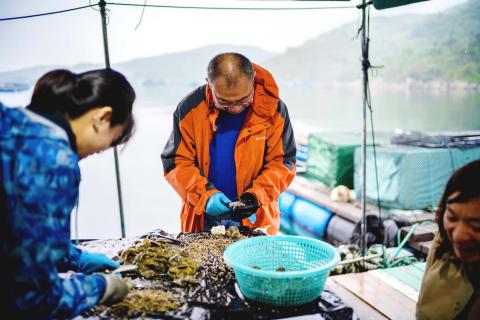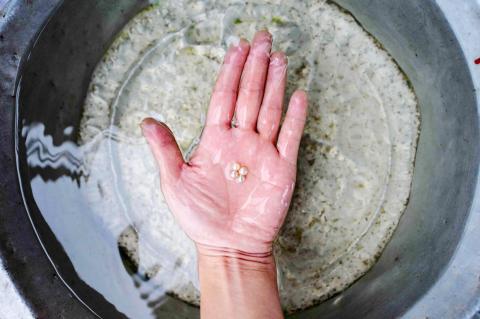On a raft floating off Hong Kong’s rural eastern coastline, former investment banker turned scientist Yan Wa-tat patiently scrapes barnacles off some 2,000 oysters — a tiresome but crucial part of his mission to bring back pearl farming.
“The species was once abundant in Hong Kong,” the 58-year-old lamented. “We have a history of pearl fishing of over 1,000 years... but because of over-fishing in Hong Kong, we only have very few of them left,” he explained.
Yan is farming Akoya pearl oysters, a specimen prized for jewelry, hoping his research will show other fishermen that the industry could be viable.

Photo: AFP
It’s a calling that requires patience. Cultured pearls take around a year to form and every few weeks Yan has to scrape away any barnacles that might compete for food with his precious oysters.
This kind of knowledge was once ubiquitous in the region. After all, the famous waterway that sustains this part of southern China — along one of the world’s most densely populated regions — is called the Pearl River.
The world’s biggest pearl, once owned by Catherine the Great and known as the “Sleeping Lion” because of its bizarre shape, is thought to have been plucked from southern China’s waters sometime in the 1700s before Dutch traders spirited it away.

Photo: AFP
And Hong Kong — dubbed the “Pearl of the Orient” by its former colonial overlords — remains the world’s largest importer and exporter of pearls, with exports topping US$1.8 billion in 2016, according to UN trade data.
But none of them are produced locally. Over-fishing and market forces have long devastated the wild pearl farming trade in the city.
Cultured pearl farming is a relatively modern industry, and a few Hong Kong ventures rose to the challenge in the 1950s. But they struggled against Japanese competitors who came to dominate the trade. The city’s last pearl farm was shuttered in 1981.
OYSTERS AND CHIPS
Now Yan and a handful of fishermen are trying to change that — with a small cottage industry combining traditional knowledge and cutting-edge technology.
Yan worked in Hong Kong’s lucrative banking sector until his mid-50s, when he decided he wanted to do something “more interesting and also more productive for our society.”
He embarked on a doctorate at Hong Kong University’s School of Biological Sciences looking at how to resurrect the city’s pearl farming trade, something he didn’t even know existed until he stumbled across it in early research.
In his lab at Hong Kong University, Yan researches the best ways to insert a radio frequency identification (RFID) chip into an oyster’s nucleus, around which a pearl will then grow — although the exact mechanism is a closely-guarded secret.
The chips are part of the same family of technology that allows users of mobile phones, transport cards and identity badges to scan into a building or to make a purchase with a simple swipe.
Yan holds a scanning device against one of his oysters and after a small bleep sound, a set of numbers appears on an app on his smartphone.
That tech has multiple benefits. Some 10 to 20 percent of nuclei are expelled by the oyster — meaning a cultured pearl is unable to form — but this is usually only discovered when prizing them open at harvest time.
Using a chip means farmers can simply scan the shell to check if a pearl has been produced.
But serial numbers will also allow buyers to know exactly where their pearls have come from, reducing the risk of fakes or lower quality scams.
NEW HARVEST
In March, a group of local fishermen inspired by Yan’s project carried out a harvest of Akoya pearls — the first to be done in Hong Kong in years.
“I think pearl farming has a future in Hong Kong,” explained Leung Kam-ming, one of the owners of a fishing raft culturing Akoya pearl oysters in the rural Sai Kung region. “I started pearl cultivation to make some extra money.”
Leung farms around 30,000 oysters, selling each cultured pearl for around HK$100 (US$12.70). Any pearls that do not meet jewelry standards can be sold along with the oyster shells as pearl powder for Chinese medicine and cosmetics.
While culturing pearls is no longer common knowledge among the Hong Kong fishing community, Leung hopes his successful harvest will set a precedent for other fishermen to follow.
And in a rare development for densely populated Hong Kong, there is plenty of space for new oyster farms.
Yan estimates some 90 percent of the 1,000 or so fishing rafts in the city’s waters are unused because so few young people wish to join the fishing trade these days.
“If I can show to the fishermen that they can make a living, diversify their income sources, then I think they will be interested in doing this,” he predicted.

April 14 to April 20 In March 1947, Sising Katadrepan urged the government to drop the “high mountain people” (高山族) designation for Indigenous Taiwanese and refer to them as “Taiwan people” (台灣族). He considered the term derogatory, arguing that it made them sound like animals. The Taiwan Provincial Government agreed to stop using the term, stating that Indigenous Taiwanese suffered all sorts of discrimination and oppression under the Japanese and were forced to live in the mountains as outsiders to society. Now, under the new regime, they would be seen as equals, thus they should be henceforth

Last week, the the National Immigration Agency (NIA) told the legislature that more than 10,000 naturalized Taiwanese citizens from the People’s Republic of China (PRC) risked having their citizenship revoked if they failed to provide proof that they had renounced their Chinese household registration within the next three months. Renunciation is required under the Act Governing Relations Between the People of the Taiwan Area and the Mainland Area (臺灣地區與大陸地區人民關係條例), as amended in 2004, though it was only a legal requirement after 2000. Prior to that, it had been only an administrative requirement since the Nationality Act (國籍法) was established in

Three big changes have transformed the landscape of Taiwan’s local patronage factions: Increasing Democratic Progressive Party (DPP) involvement, rising new factions and the Chinese Nationalist Party’s (KMT) significantly weakened control. GREEN FACTIONS It is said that “south of the Zhuoshui River (濁水溪), there is no blue-green divide,” meaning that from Yunlin County south there is no difference between KMT and DPP politicians. This is not always true, but there is more than a grain of truth to it. Traditionally, DPP factions are viewed as national entities, with their primary function to secure plum positions in the party and government. This is not unusual

US President Donald Trump’s bid to take back control of the Panama Canal has put his counterpart Jose Raul Mulino in a difficult position and revived fears in the Central American country that US military bases will return. After Trump vowed to reclaim the interoceanic waterway from Chinese influence, US Defense Secretary Pete Hegseth signed an agreement with the Mulino administration last week for the US to deploy troops in areas adjacent to the canal. For more than two decades, after handing over control of the strategically vital waterway to Panama in 1999 and dismantling the bases that protected it, Washington has